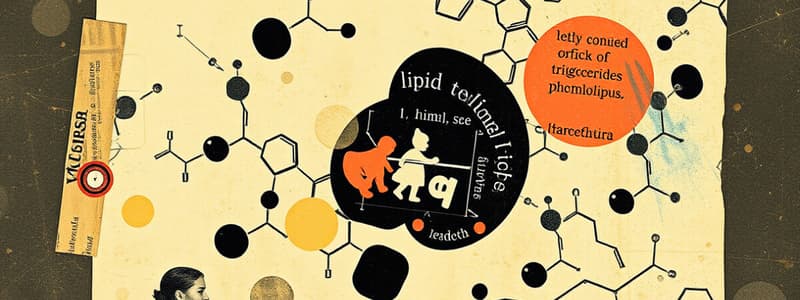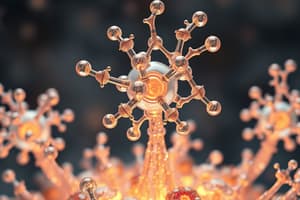Podcast
Questions and Answers
What are the characteristics of lipids?
What are the characteristics of lipids?
- Insoluble in organic solvents (correct)
- Contain Carbon, hydrogen and oxygen (correct)
- High proportion of oxygen to carbon and hydrogen
- Soluble in water
What are the main groups of lipids?
What are the main groups of lipids?
Triglycerides, phospholipids, waxes
What is a triglyceride?
What is a triglyceride?
An individual lipid molecule made up of a glycerol molecule and three fatty acids.
How do lipids serve as an energy source?
How do lipids serve as an energy source?
What role do lipids play in waterproofing?
What role do lipids play in waterproofing?
How do lipids provide insulation?
How do lipids provide insulation?
What is the function of lipids as electrical insulators?
What is the function of lipids as electrical insulators?
How do lipids provide protection?
How do lipids provide protection?
Lipids are soluble in water.
Lipids are soluble in water.
What is the role of lipids in hormone production?
What is the role of lipids in hormone production?
Fats are liquid at room temperature.
Fats are liquid at room temperature.
What type of bond is formed when fatty acids bond with glycerol?
What type of bond is formed when fatty acids bond with glycerol?
What occurs during a condensation reaction?
What occurs during a condensation reaction?
What is hydrolysis?
What is hydrolysis?
What causes variation in the properties of fats and oils?
What causes variation in the properties of fats and oils?
What characterizes saturated fatty acids?
What characterizes saturated fatty acids?
What is a mono-unsaturated fatty acid?
What is a mono-unsaturated fatty acid?
What defines a polyunsaturated fatty acid?
What defines a polyunsaturated fatty acid?
What is the result of double bonds in fatty acids?
What is the result of double bonds in fatty acids?
What defines phospholipids?
What defines phospholipids?
What are the two parts of a phospholipid?
What are the two parts of a phospholipid?
What are polar molecules?
What are polar molecules?
How is the test for lipids conducted?
How is the test for lipids conducted?
Why does a positive test for lipids result in a cloudy-white color?
Why does a positive test for lipids result in a cloudy-white color?
Flashcards are hidden until you start studying
Study Notes
Characteristics of Lipids
- Composed of carbon, hydrogen, and oxygen.
- Lower oxygen-to-carbon and hydrogen ratio compared to carbohydrates.
- Insoluble in water and organic solvents like alcohol and acetone.
Main Groups of Lipids
- Triglycerides (fats and oils)
- Phospholipids
- Waxes
Triglycerides
- Comprised of one glycerol molecule linked to three fatty acids.
Role of Lipids as an Energy Source
- Fatty acids have long hydrocarbon tails rich in chemical energy.
- Lipids yield more than double the energy of carbohydrates per mass and produce valuable water upon oxidation.
Role of Lipids in Waterproofing
- Large nonpolar molecules, lipids are effective for waterproofing in plants and insects.
- Waxy lipid cuticles help conserve water.
Role of Lipids in Insulation
- Serve as poor conductors of heat, aiding in heat retention under the skin.
Electrical Insulation
- Lipids form myelin sheaths around neuron axons, preventing premature conduction of nerve impulses.
Protection
- Fat surrounding vital organs acts as a shock absorber.
Insolubility of Lipids
- Lipids do not dissolve in water, preventing osmotic pressure that could cause cells to swell.
Hormone Production
- Lipids are essential for the formation of steroid hormones, including oestrogen and certain plant growth hormones.
State of Fats vs. Oils
- Fats are solid at room temperature (10-20°C), in contrast to liquid oils.
Type of Bond in Triglycerides
- Fatty acids bond to glycerol via ester bonds.
Chemical Processes
- Condensation Reaction: Molecules combine to form a complex one, typically releasing water.
- Hydrolysis: Larger molecules break down into smaller units with the addition of water.
Variations in Properties of Fats and Oils
- While glycerol is consistent in all triglycerides, differences arise from variations in fatty acids; over 70 distinct fatty acids exist.
Saturated Fatty Acids
- Contain maximum hydrogen atoms, no carbon double bonds.
Unsaturated Fatty Acids
- Mono-unsaturated Fatty Acids: Feature one carbon double bond.
- Polyunsaturated Fatty Acids: Contain multiple carbon double bonds, causing bends in structure.
Effect of Double Bonds
- The presence of double bonds prevents tight packing of molecules, resulting in liquids at room temperature.
Phospholipids
- Composed of two fatty acids and one phosphate group, exhibiting hydrophilic properties.
Structure of Phospholipids
- Hydrophilic "Head": Interacts with water.
- Hydrophobic "Tail": Repels water and mixes with fats.
Polar Molecules
- Exhibit dual properties (polar ends), leading phospholipids to orient with heads near water and tails away from it.
Test for Lipids
- Procedure involves using ethanol to dissolve lipids, followed by adding water to observe for a cloudy white emulsion.
Cloudy White Color in Lipid Test
- Result of lipid dispersion in water, creating an emulsion that refracts light, giving a cloudy appearance.
Studying That Suits You
Use AI to generate personalized quizzes and flashcards to suit your learning preferences.



